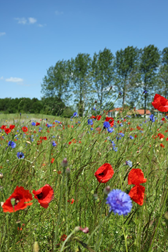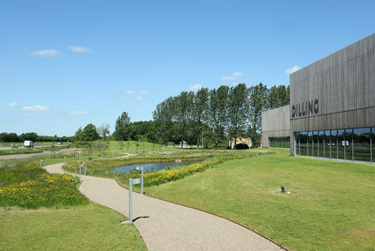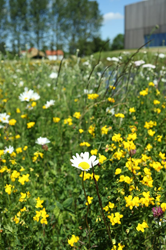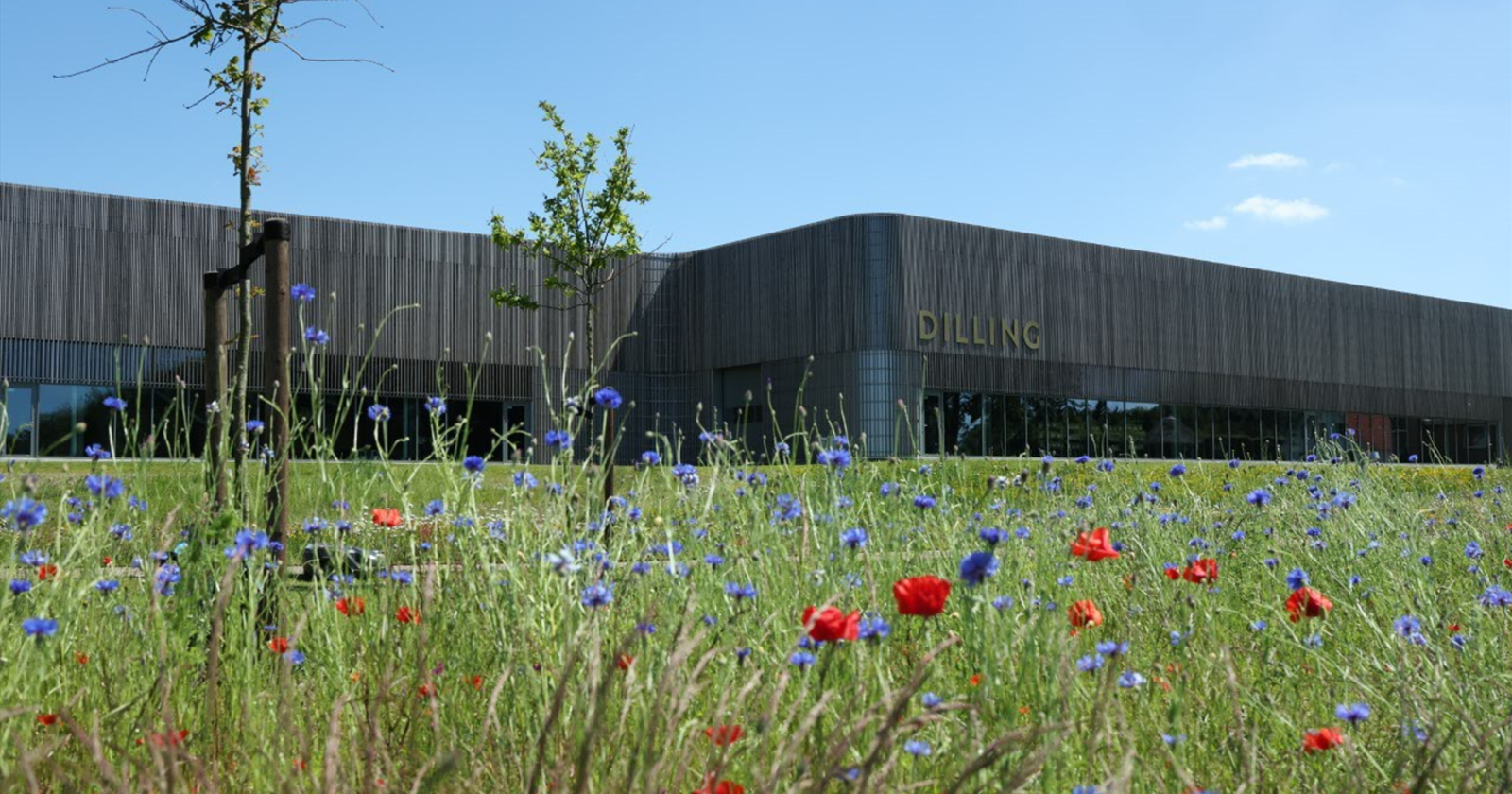Biodiversity is about creating space for bees, flowers, and other wild plants, but it also requires leadership courage. When a company decides to replace a well-manicured lawn with tall grass and wildflowers, it can raise questions among others. What will people think? Does it mean the company is going bankrupt?
Morten Dilling, CEO and fourth generation at DILLING, an underwear company that has worked with sustainability for many years, has faced this challenge. The company has traditionally focused on purity and ecology but has recently expanded its commitment to biodiversity. The once well-maintained lawn has now been replaced with wildflowers like chamomile, dandelions, and daisies—flowers that are vital for supporting the endangered insects.
The story of this shift begins with DILLING’s need for more space, leading to a redesign of the company’s surroundings with the help of architects C.F. Møller. In this process, a hilly landscape with ponds and nature was created around the company. A conversation with a journalist from Copenhagen, who mentioned the TV program "Give Us Nature Back," sparked a realization in Morten Dilling about how he could promote biodiversity at DILLING. He realized that the well-manicured lawn wasn’t just pretty – it was a dry savannah that was harming the insects.
Dilling acknowledged that his old way of mowing the grass couldn’t continue, and it became a challenge to convince his father that the company needed to think differently. In collaboration with the program's biologist and nature guide, Morten D.D. Hansen, DILLING received advice on how to promote Danish biodiversity with local species like cuckoo flower, wild carrot, and cranesbill—instead of imported flowers that didn’t offer the same value for insects.
DILLING’s story shows that although the transition from lawn to wild nature may seem like a big change, it is a step toward supporting biodiversity and doing something good for nature. It’s about experimenting, finding the balance between the wild and the controlled, and taking the first steps toward a more sustainable future.



It Takes Courage to Let Go
In fact, Morten Dilling believes the process has been quite straightforward when it comes to the practical and economic aspects. The challenge with biodiversity was primarily that it was so radically different from what DILLING had been doing before.
"It takes both courage and a prioritization of time, which of course takes away from developing the business. But I had promised the people behind ‘Give Us Nature Back’ that I, together with other companies in Herning, would look into the possibilities. So about 30 business leaders went on a bus tour with them. Especially Midtgård Farver and I were inspired by what we saw and heard. We got a common push to get started."
Morten Dilling explains that business owners are deeply invested in making sure things look neat. Therefore, you still see plenty of manicured lawns around, as it takes courage to let go of control.
"At first glance, biodiversity may look like chaos, and we want so badly to signal control. What if others think you’re not in charge of your business? It’s a matter of pride that many business leaders struggle with. The process requires you to let go. That wasn’t what concerned me the most. Actually, it was more about whether I should prioritize the time – and rethink how we’ve been working with the surrounding areas for generations."
Once the decision was made, biodiversity became a little beehive of rewards. For starters, there are low-hanging fruits like publicity. Attention to DILLING has increased in a positive way, and the wild surroundings are embraced by both PR and positivity.
But in fact, it is the joy that Morten Dilling highlights.
"When I go outside on a summer day and experience all the life around, I’m so happy. It’s wonderful to observe the life out there. To see how there are almost no insects when it’s cloudy and cold. But as soon as the sun comes out, they’re everywhere. There’s life in a whole new way here – and it’s amazing."
Morten Dilling’s Advice to Companies Wanting to Start with Biodiversity:
-
Start right away. Don’t think it’s not the right season. It’s NOW. Start simple. For example, by not mowing the lawn.
-
Even if a castle garden looks nice, you don’t need it. But it’s okay to mow the grass in some areas. Combine the wild with the controlled.
-
Be patient. If you’ve been fertilizing your grass for years, you’ll need to work with it. Plant Danish species like wild carrot, bluebell, yarrow, cranesbill, bellflower, cuckoo flower, and foxglove. That way, butterflies and bees will have a great pantry.
-
Create insect hotels, because insects not only need food, they also need a place to live. You can contribute by leaving large tree trunks, building stone piles, or creating ponds.
-
Get inspiration from others who know a bit about biodiversity. It’s quite simple to get started – and then you can build from there.
-
Accept that Rome wasn’t built in a day. In the beginning, it might look a bit hopeless, but it gets better year after year. We’re starting our third season, and I can hardly wait.
Possible Reasons Why Companies Haven’t Worked with Biodiversity Yet:
-
Lack of knowledge and awareness about biodiversity and its significance for the company itself and society as a whole.
-
Short-term financial goals that prevent investment in and protection of biodiversity.
-
If customers and stakeholders aren’t asking for initiatives, it’s not top of mind for the company.
-
Old habits about maintenance, and therefore concern about how the public will react to the wild appearance.
Possible Benefits for Companies Working with Biodiversity:
-
An enhanced reputation, as engagement in biodiversity signals responsibility toward society and the planet.
-
Biodiversity efforts can inspire innovation, as you challenge your usual thoughts and behavior patterns.
-
Access to new collaborations and investments from actors committed to sustainable development and environmental protection.
-
A chance to differentiate yourself in the market, as many other companies are still not taking action.
Read more about Dilling on their website here:
